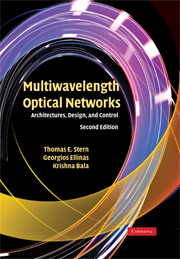Book contents
- Frontmatter
- Contents
- Figures
- Tables
- Preface to the Second Edition
- Acknowledgments
- Multiwavelength Optical Networks
- 1 The Big Picture
- 2 The Layered Architecture and Its Resources
- 3 Network Connections
- 4 Enabling Technology
- 5 Static Multipoint Networks
- 6 Wavelength/Waveband-Routed Networks
- 7 Logically-Routed Networks
- 8 Survivability: Protection and Restoration
- 9 Optical Control Plane
- 10 Optical Packet-Switched Networks
- 11 Current Trends in Multiwavelength Optical Networking
- A Graph Theory
- B Fixed Scheduling Algorithm
- C Markov Chains and Queues
- D A Limiting-Cut Heuristic
- E An Algorithm for Minimum-Interference Routing in Linear Lightwave Networks
- F Synopsis of the SONET Standard
- G A Looping Algorithm
- Acronyms
- Index
3 - Network Connections
Published online by Cambridge University Press: 05 June 2012
- Frontmatter
- Contents
- Figures
- Tables
- Preface to the Second Edition
- Acknowledgments
- Multiwavelength Optical Networks
- 1 The Big Picture
- 2 The Layered Architecture and Its Resources
- 3 Network Connections
- 4 Enabling Technology
- 5 Static Multipoint Networks
- 6 Wavelength/Waveband-Routed Networks
- 7 Logically-Routed Networks
- 8 Survivability: Protection and Restoration
- 9 Optical Control Plane
- 10 Optical Packet-Switched Networks
- 11 Current Trends in Multiwavelength Optical Networking
- A Graph Theory
- B Fixed Scheduling Algorithm
- C Markov Chains and Queues
- D A Limiting-Cut Heuristic
- E An Algorithm for Minimum-Interference Routing in Linear Lightwave Networks
- F Synopsis of the SONET Standard
- G A Looping Algorithm
- Acronyms
- Index
Summary
The multiwavelength network architecture described in Section 2.1 contains several layers of connections. By exploiting the various alternatives in each layer, it is possible to produce a rich set of transport network configurations. This chapter explores how a desired connectivity pattern can be established using the combined functionality contained in the various layers. The approach is to examine the properties of different classes of networks through a sequence of simple illustrative examples. The design objective in each example is to provide a prescribed connectivity to a set of end systems. Each of the network classes illustrated in this chapter is discussed in more detail in later chapters, as is the issue of optical network control.
Our first example is shown in Figure 3.1. Five geographically dispersed end systems are to be fully interconnected by a transport network, which is to be specified. The end systems might correspond to physical devices such as supercomputers that interact with each other, or they may be gateways (interfaces) to local access subnets (LASs) serving industrial sites, university campuses, or residential neighborhoods.
In all of these cases, a dedicated set of connections is desired (shown as dashed lines in the figure), providing full connectivity among all the sites. Figure 3.2(a) shows one possible transport network, whose physical topology (PT) is a star, in which the central node is a star coupler of the type shown in Figure 2.7(a). Each end system is connected to the star through its own network access station.
- Type
- Chapter
- Information
- Multiwavelength Optical NetworksArchitectures, Design, and Control, pp. 91 - 164Publisher: Cambridge University PressPrint publication year: 2008

